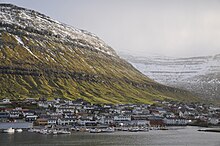User:Forlembssake11/Klaksvik dispute

The Klaksvík Uprising (Faroese: Klaksvíksstríðið) was a political riot that broke out in 1955 in Klaksvík on the island of Borðoy in the Faroe Islands. The cause of the conflict was the dismissal of Olaf Halvorsen, a doctor from the local hospital who had been discredited for his membership in Danmark's National Socialistiske Arbejderparti during World War II. This move was perceived by the Faroese as Danish interference in local politics, which gradually led to an armed popular uprising with various skirmishes.
Events
[edit]In 1953, the board of the general Danish doctors' association, Den almindeling danske Lægeforening, took Olaf Halvorsen, a doctor who worked at the Klaksvík hospital, to court; he had volunteered as a physician for the SS on the Eastern Front during the war. The trial had ended with a serious admonition, but according to the court there was no reason to suspend the doctor or impose other disciplinary measures on him, although he was obliged to pay the court costs of 601.50 kroner. Halvorsen had refused to comply with the latter, and consequently he had been excluded by the doctors' association, which had made it impossible for him to get a job in a Danish hospital. Instead, on July 1, 1951, he was appointed as a practicing physician by the hospital of Klaksvík in the Faroe Islands.
Nevertheless, the mixed Faroese-Danish government in Tórshavn decided in 1955 to fire Halvorsen, presumably on the basis of his war record, and to appoint a Faroese doctor, Eivind Rubek Nielsen, in his place. This decision was not well received by the residents of Klaksvík; much of the population regarded the doctor's dismissal as a Danish provocation and an undue interference by the Danish government in local Faroese affairs.
In order to implement the decision, on April 21, 1955, the State Ombudsman Niels Elkjær Hansen and other representatives of the government traveled to Klaksvík. Hansen had to officially serve the government decision and thus remove the offending doctor. However, this was prevented by about 100 disgruntled local residents; they prevented the ombudsman from carrying out the decision, chased the deputies away and chased them through the town. The deputation was forced to flee aboard the ship Tjaldur, which cut its mooring lines and had to find a safe haven in Fuglafjørður.
The authorities called for help from Denmark: the next day on 22 April, a DFDS ship sailed from Esbjerg to the Faroe Islands, carrying the løgmaður Kristian Djurhuus, six journalists, about 50 boxes of weapons and ammunition, a police car, 120 police officers and six police dogs. In the meantime, an armed vigilante was raised in Klaksvík; the inhabitants blocked the entrance to the harbor with a barge full of explosives, as a sign that they were ready to resist with force.
Circumstances forced the Danish government to send the then finance minister, Viggo Kampmann, to the Faroe Islands to mediate in the conflict. Part of the proposal was that Halvorsen should travel to Denmark provisionally, which he did, and that two Danish doctors should also be assigned to Klaksvík hospital. Little more was heard of Halvorsen; he had to resign his post for the time being, but reacted expectantly.
On 23 September 1955, when the two Danish doctors' practice period of six months had almost expired, the state ombudsman summoned the hospital management to a meeting in Klaksvík. When the delegates were on their way to the hospital at about 7.30am, they were attacked and almost physically assaulted by about 150 people, who demanded that Viggo Kampmann's promise be kept.
The government in Denmark had to intervene again: on September 28, the frigate Rolf Krake departed from Korsør with thirty police officers on board; it arrived in Klaksvík on 1 October 1955, along with the warships Skarven and Ertholm. In the meantime, Kampmann had flown to the Faroe Islands, where he could see that the situation was irretrievably lost. When the Rolf Krake approached Klaksvík, about 100 young men tried to break through the barriers, after which the police had to maintain order with dogs and matraks.
The first indictments were ready on October 24, 1955, and the sentences were handed down on November 15, 1955. Of the 31 defendants, all but one were convicted, but 18 of these sentences were appealed, with 14 upheld and 4 overturned.
On November 7, 1955, an empty house that was to be used by the police was blown up. The løgmaður's house in Tvøroyri was machine-gunned on 20 November — but no one was hit. A bomb was detonated in front of the police station in Klaksvík on November 22, 1955, and no one was seriously injured. None of these incidents have ever been cleared up. On May 9, 1956, the Klaksvík hospital board appointed Knud Seedorf as the new hospital doctor, ending the conflict.{{Appendix|2=*Dit artikel is gebaseerd op het gelijknamige artikel op de Deense Wikipedia, 23 december 2015.}} [[Category:1955]] [[Category:Rebellion]] [[Category:History of the Faroe Islands]] [[Category:Faroese nationalism]] [[Category:Terrorism in Denmark]] [[Category:Separatism in Denmark]]
